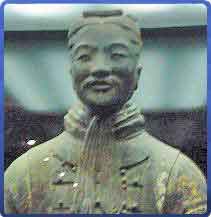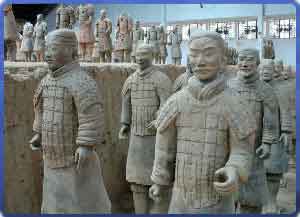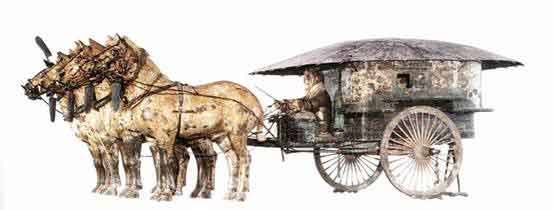
 |
||||
|---|---|---|---|---|
“The Terracotta Warriors of Qin” is a spectacular exhibition which recreates one of the greatest archaeological finds of the 20th Century - the terracotta army of Qin Shihuang, the first Emperor of China and one of the great military leaders of history.
In 247 BC, when the future Emperor was only 13, his father died and he ascended the throne as the King of Qin. He later set about conquering the six other feudal states, and succeeded in 221 BC. He unified the territories and at the age of 39 declared himself to be "Qin Shihuang Di" - the first Emperor of China.
He built the Great Wall, introduced coinage which remained virtually unchanged for 2,000 years, standardised the written word and weights and measures - and sought the secret of immortality … while at the same time building his tomb.
Work on his Mausoleum started soon after the 13-year-old became King of Qin. It is estimated that as many as 720,000 conscripts worked on the project, and construction took 38 years - beginning in 247 BC and not finishing until 208 BC, two years after his death.
The ancient Chinese had a strong belief in the afterlife and believed that ‘the underworld’ would be a continuation of their present life. So to make that adventure as pleasant as possible, the First Emperor’s tomb re-created the most lavish palace imaginable.
And because in this life he saw enemies everywhere, he created an army of warriors to protect him in the afterlife.
His concubines (3000 of them) who had no children were ordered to follow him to the grave; and to protect the secrets of his burial, thousands of officials and tomb builders were buried alive with his body.
These measures were so effective that the secrets of Qin Shihuang were not discovered for 2200 years… Then, on March 29, 1974, farmers in Lintong County, who were drilling in search of water, came across pottery fragments and ancient bronze weapons.
 |
|---|
Exhibition Presentation
“The Terracotta Warriors of Qin” exhibition recreates the astonishing discoveries uncovered by those who opened up pits that held over 8,000 incredibly detailed figures - a fully equipped army lined up in battle formation, along with horses and chariots.
These warriors including officers, infantry, crossbow and cavalry men as well as their horses are known as the Terracotta Army - described as “the eighth wonder of the world.”
• The Exhibition features a spectacular display of more than 80 life-sized terracotta figures, charioteers and horses which have been carefully recreated by technicians from the original Museum, who restored and preserved the warriors.
Other objects, including coins used and weapons found with the soldiers, are also displayed, and virtual recreations show how the weapons were used and held by the soldiers. (The weapons they carried were real and as sharp today as they were twenty-two centuries ago.)
Visitors can use large touchscreens to zoom in on high quality images and study any part of the warriors - different hairstyles and headgear, moustaches and beards, faces (no two faces are alike, and it’s likely the workers who made the soldiers modelled them after the real soldiers of Emperor Qin’s army), uniforms, belts and even shoes.
The background and surroundings are brought to life using photographs and artefacts, videos and unique, full-colour digital interactive reconstructions.
Specially selected music and sound and lighting effects complement the exhibits, to create a completely authentic experience and bring the exhibition stunningly to life.
 |
|---|
• Another major feature of the Exhibition is a full-sized recreation of the bronze chariot and horses unearthed near Emperor Qin's Mausoleum in December, 1980. The buried model was supposed to serve as the vehicle for the emperor's inspection tours in his afterlife.
The colourful carriage is decorated with geometric and cloud patterns; coachmen armed with swords guard the chariot on both sides. The horses are adorned with gold and silver and the roof is umbrella shaped, said to be symbolic of the round sky.
When excavated, the chariot and horses were smashed into thousands of pieces, and it took eight years of painstaking work to restore them.
The original chariot can never leave China and this replica has been meticulously recreated down to the last detail. It is exactly the same size as the chariot and horses in the tomb.
Very few exhibitions anywhere in the world have ever displayed examples of the chariot.
|
|||||||||||||||||||||||||
|---|---|---|---|---|---|---|---|---|---|---|---|---|---|---|---|---|---|---|---|---|---|---|---|---|---|
For further information contact: TerracottaWarriors@HeronExhibitions.com